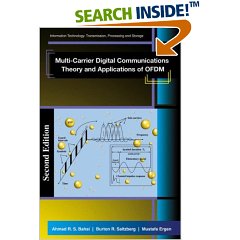|
Multi Carrier
Digital Communications: Theory and
Applications of OFDM
Multi-Carrier Digital Communications Theory and Applications
of OFDM, Second Edition Multi-carrier modulation, Orthogonal Frequency
Division Multiplexing (OFDM) particularly, has been successfully applied to a
wide variety of digital communications applications over the past several
years. OFDM has been chosen as the physical layer standard for a variety of
important systems and its implementation techniques continue to evolve
rapidly. This book is a valuable summary of the technology, providing
an understanding of new advances as well as the present core technology. A
unified presentation of OFDM performance and implementation over a wide
variety of channels, including both wireline and wireless systems, is made.
This will prove valuable both to developers of such systems and to researchers
and graduate students involved in analysis of digital communications. In the
interest of brevity, the authors have minimized treatment of more general
communication issues. There exist many excellent texts on communication
theory and technology. Only brief summaries of topics not specific to
multi-carrier modulation are presented in this book where essential. As a
background, it is assumed that the reader has a clear knowledge of basic
fundamentals of digital communications. Highlights of the Second Edition During the past few years
since the publication of the first edition of this text, the technology and
application of OFDM have continued their rapid pace of advancement. As a
result, it became clear that a new edition of the text would be highly desirable.
The new edition provides the opportunity to make those corrections and
clarifications whose need became apparent from continued discussions with
many readers. However, the main purpose is to introduce new topics that have
come to the forefront during the past few years, and to amplify the treatment
of other subject matter. Because of the particularly rapid development of wireless
systems employing OFDM, the authors introduced a section early in the text on
wireless channel fundamentals. They have extended and modified their analysis
of the effects of clipping, including new simulation results. A section of
channel estimation has been added to the chapter on equalization. The chapter on local area networks has been greatly expanded
to include the latest technology and applications. Three totally new chapters are added, on OFDM multiple access
technology, on ultra wideband technology, and on WiMAX (IEEE 802.16). Organization of This Book The authors begin with a
historical overview of multi-carrier communications, wherein its advantages
for transmission over highly dispersive channels have long been recognized,
particularly before the development of equalization techniques. They then
focus on the bandwidth efficient technology of OFDM, in particular the
digital signal processing techniques that have made the modulation format
practical. Several chapters describe and analyze the sub-systems of an OFDM
implementation, such as clipping, synchronization channel estimation,
equalization, and coding. Analysis of performance over channels with various
impairments is presented. The book continues with descriptions of three very important and diverse applications of OFDM that have been standardized and are now being deployed. ADSL provides access to digital services at several Mbps over the ordinary wire-pair connection between customers and the local telephone company central office. Digital broadcasting enables the radio reception of high-quality digitized sound and video. A unique configuration that is enabled by OFDM is the simultaneous transmission of identical signals by geographically dispersed transmitters. And, the new development of wireless LANs for multi-Mbps communications is presented in detail. Each of these successful applications required the development of new fundamental technology. Finally, the book concludes with describing the OFDM based multiple access techniques, ultra wideband technology and WiMAX. Send mail to
here with questions or comments
about this web site. |
|||||||||||
|
Table of Contents: Preface 1 Introduction
to Digital Communications 2 System Architecture 3 Performance
over Time-Invariant Channels 4 Clipping in Multi-Carrier Systems 5
Synchronization 6 Channel Estimation and
Equalization 7 Channel
Coding 8 ADSL |
9 Wireless LAN
Applications |
10 Digital Broadcasting 10.3 Other Digital Broadcasting Systems 11 OFDM based
Multiple Access Techniques 12 Ultra WideBand Technologies 13 IEEE 802.16
and WiMAX 14 Future Trends Bibliography |
|||||||||
